Dear Artist,
An elite art instructor has grown disillusioned with teaching. When asked if she could identify gifted students, she replied that talent was often lacking but audacity was in great supply. “Audacity” she said, “will only get you so far without talent or work. The greatest predictor of success in an aspiring artist, therefore, is work.”
The problem, she said, is that her students were constantly looking for shortcuts — the intensity of which seemed correlated to their level of audacity. Micro attention spans, the instant gratification of social media and lots of stuff to copy, she said, made newbies impatient with the actual process of making art. Instead, “process” felt like a kind of tedious chore on the road to adulation. “Good art just doesn’t work that way,” she lamented. “How do I inspire students to fall in love with the process? Perhaps that system is too old-fashioned to be of any value anymore.”
And what about talent? It is, perhaps too contentious or at least in its purest form, too rare to rely upon when fingering greatness. “Don’t bother about whether or not you have it,” wrote Richard Schmid. “Just assume that you do, and then forget about it. Talent is a word we use after someone has become accomplished. There is no way to detect it before the fact… or to predict when or if mastery will click into place.” While anyone who has ever listened to Mozart may disagree, modern savvies Pollock, Rauschenberg, Munch — even George Lucas — didn’t think much of it or even believe they had it in any great or special supply. It is perhaps easier for us mortals to diminish its role, lest we die in a pile of our own non-Mozarty mediocrity.
While we can all then agree that work is the dreammaker, what does that look like? To a futurist, the slogging sacrifices of La Belle Époque and its requisite garrets are nothing more than pathetic and non-applicable throwbacks. What is the future of work? It may be something entirely unrecognizable to an old-school, steadfast plodder. “Work is love made visible,” wrote Kahlil Gibran in 1923. And so the question could be better understood as, “what is the future of love?”
Sincerely,
Sara
PS: “The artist is nothing without the gift, but the gift is nothing without work.” (Émile Zola)
Esoterica: While watching the Olympics with my Mum this week, I blurted, awestruck, “Imagine devoting your life to trying to swim faster?” She replied, “Like devoting your life to trying to make better paintings.” In that moment, I felt both entirely seen by her and connected to every individual still subscribing to the slog system. “The work of a man is the explanation of the man,” wrote Paul Gauguin. I wrote to my teacher friend to offer some words of condolence: “You cannot teach writing,” I remembered a man in a movie saying, once. “You can only expose your students to good work and hope it inspires them.” Once inspired, there will be those special desperados who are driven to attempt to climb to the level of their heroes in quality of ideas, execution and communication — in impact. In their compulsion to reach that place, they may, just, take the long route, and fall in love with the process.
“Talent renders the whole idea of rehearsal meaningless. When you find something at which you are talented, you do it – whatever it is – until your fingers bleed or your eyes are ready to fall out of your head.” (Stephen King)
Have you considered a Premium Artist Listing? With each letter, an artist is featured at the bottom of this page. The Premium Artist Listings are a means of connecting artist subscribers through their work. Proceeds from each listing contribute to the production of The Painter’s Keys.
“It’s none of their business that you have to learn how to write. Let them think you were born that way.” (Ernest Hemingway)
Featured Workshop
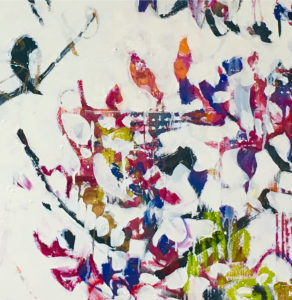 Join Ellie Harold for “Intuitive Painting: Permission to Paint Expressively,” designed especially for mature women artists of all skill levels who wish to explore this medium for soulful exploration. The retreat provides attractive accommodations (your own room!) along with lightly structured activities for centering, relaxation and low stress art-making. You’ll have plenty of free time to muse, paint, write and reflect while enjoying the colors, textures and flavors of San Miguel. This Retreat has the potential to transform not only your art but your life! You’ll return home with a specific art “care plan” to assure support for further creating. Details at www.EllieHarold.com.
Join Ellie Harold for “Intuitive Painting: Permission to Paint Expressively,” designed especially for mature women artists of all skill levels who wish to explore this medium for soulful exploration. The retreat provides attractive accommodations (your own room!) along with lightly structured activities for centering, relaxation and low stress art-making. You’ll have plenty of free time to muse, paint, write and reflect while enjoying the colors, textures and flavors of San Miguel. This Retreat has the potential to transform not only your art but your life! You’ll return home with a specific art “care plan” to assure support for further creating. Details at www.EllieHarold.com.
Featured Artist
Christine Hanlon, whose work has been compared to that of Edward Hopper, creates ‘urban landscapes which quietly exude atmosphere.’


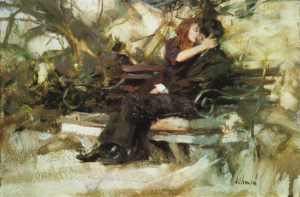
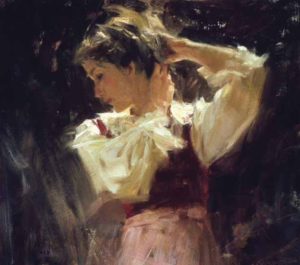
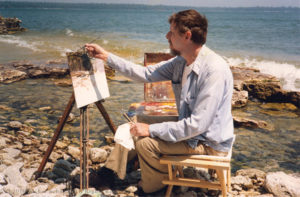
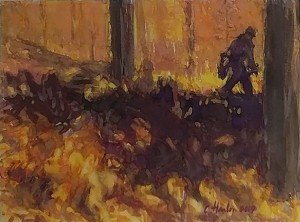



27 Comments
“The writings of Sara Genn meet at the intersection of poetic and informative.”
– Miles Patrick Yohnke, https//yohnke.com
This article is your finest. Your Dad would be so proud. I am so proud of you.
With much love,
Miles Patrick Yohnke
Well, this is no surprise me. I worked day and night for what I have ,with my teacher and mentor, and loved every bit of it. Then one day it happened , I tuned the corner !
I’ve been teaching for years but had very few who would work at leaning the fundamentals of painting. Most wanted a “ quick fix” or to just “ do their own thing”, because they didn’t want to be told. In spite of that I truly tried to convey the excitement of learning . I found the older children were much easier to teach than the adults. Most of the young ones would just do what I asked. The older (adults) would argue with me.
Seems , well in my town anyway, no one wants to know what “Art” is all about, they just want a “ picture. ( usually of their grand baby )
I haven’t read all your work, Sara, so this may not be your finest, but it is brilliant. Thank you for writing it. And Miles, thank you for pointing it out so poetically.
Sara, your mother is so wise and this might be my favourite article so far. I think I shall first share it in a painter group I am part of and then tuck it away for future reference. I am a long hauler, a slogger who doesn’t shy away from doing what is necessary to find homes for my finished work but it is not my motivation. The process is what drives me. The next idea is what gets me out of bed and throwing my red paint apron over top of my white nightgown to straighten a horizon line, while the water is boiling for coffee and the sun is just catching the top of the trees. The process is what sends me back to a large canvas painted live in the gallery (with the paints I had already taken back to the home studio) to add one last brushstroke. I can easily tell when my work is done. I can even tell if it is reasonably good. But I will never know if it is (or ever will be) great or important or significant today or in 200, 300 or even 500 years from now. This is not part of my job. My job is to do the best work I possibly can and never stop learning and inquiring and exploring the deep questions that are meaningful to me. That is all. When this is done for the day, then I can put my brush down and get up and do it all over again tomorrow. Thanks for the company Sara and so many other here are also taking the long way.
I agree 100% with Miles. Great letter. I see myself in it. I love the Stephen King quote. Nothing’s bleeding yet and eyes still in sockets. Still have a long way to go.
Beautiful article. Thank you for enriching my day and my work
Having been a university fine art and art history professor for four decades, I know that talent may help initially, but ultimately it takes an inspiration and encouragement from someone like a teacher, to push the student along until his or her confidence takes over. Inspiration coupled with confidence and desire/ passion will motivate the student, although the student must also never give up or be afraid of failure…instead continue to be tenacious and eventually he or she will succeed. Success can be interpreted in a number of ways and like everything else in Life, it is relative to something else. Of course there are no guarantees in Life and certainly plenty of artists may succeed at creating competent drawings and paintings although still not find success in the market place. Van Gogh is the classic case of being an original artist who painted with passion and commitment but never succeeded financially. And there are countless other artists who’ve never “made it” in their lifetime who nevertheless are good artists by anyone’s standards. I think ultimately one must feel satisfaction in what one accomplishes without worrying about being a financial success. One can live a rich and rewarding life without becoming famous and or monetarily rich. Neill Slaughter, Professor Emeritus, Long Island University
Richard Schmid and Nancy Guzik were and are eternal lovers. Twim flames. When I took a workshop from Nancy a few years back, she absolutely glowed when speaking of her husband. He passed away this year and I can’t imagine her sorrow.
As for the goal of swimming faster and faster (or any other sport), there comes a time when it’s over. Not so with the painter. Sara, your dear father was still painting, I am certain, as he took his last breath.
Golden words, Sara!
You have married one of my favourite painters with one of my favourite topics. Good on you!
I can’t believe Richard has passed and left Nancy to grieve. What a loss!
I love that Richard Schmid said about Talent-‘ just assume you have it, and move on’
Hi Sara ! I am in agreement with other comments . Your musing and wisdom shined brilliantly in the truth of your comments . I was a avid follower of your Father and have become a avid follower of your artistic thoughts as well . As your Dad would say –EMTD .” ENTHUSIASM MAKES THE DIFFERENCE ” . I posted that in my studio and often look at it and remember the wisdom of that simple comment . You definitely share genetic makeup from Robert ! Thank God for that ! We need guidance as artists ! Enjoy Today !
I remember the moment when I found joy in realizing that it is not about completing a painting but about the process of discovery as I work on a painting. I also discovered that if I worked hard at learning when I was in art school I could feel my own success in the process….. now I can continue to learn and discover and create on my own …. And I mostly love the process of expanding and capturing my own creative ideas.
Dear Sara,
I am so grateful for your company. It is a relief to not have to defend my love of process; of what if. I do it, I put it in the drawer and sometimes I look through the drawer and laugh at having forgotten doing that one. My eternal question is “how can I get down what I see” I so love the process that is totally consuming and joyful.
Thank you.
In order to be a “successful” artist, you need 4 things:
1. talent : some innate aptitude
2. training: learn the nitty gritty of composition, color, line, perspective, etc. Includes learning from teachers and mentors as well as looking at great art.
3. inspiration: why are you painting? What do you love? What moves you to create?
4. discipline: get in your studio and work, even when it is unbearably difficult.
All successful painters have these 4 things. Financial success is an entirely different thing.
Really thought provoking and right on the money. Thanks for your clear and ‘creative’ thinking Sara – it is inspiring.
What a great article. I have taught art to both teens and retirees. Your teacher friend has my blessings. The teen class was a three-day experiment which I would never do again. “Micro attention spans” indeed. The retirees are wonderful, and are not busy checking their phones.
Pauline Conn, your comment is “deja vu” for my experience with teen students. I taught “Drawing on the Right Side of the Brain” by Betty Edwards to retirees and had students begging for homework, they arrived early to class, never looked at their phones, and were excited to try new techniques! Those were the most rewarding classes I have ever taught!
Finding something you love to do and are compelled to do it a lot and to do it better and better, is less about talent than accomplishment.
Work, gift , love…wonderful words and letter Sara. To practice these things is the artistic way! Innate or acquired talent is nurtured. It’s a life’s journey and some people have done it especially well and I look up to them. Thank you.
It’s certainly something we all ponder when we go our studios by ourselves, alone with only our own thoughts, maybe some soul restoring music to help our minds from being too loud with the internal voices. I wonder why I take to this roller coaster of making art when I drop to such self deprecating lows. I suck, I have no talent, I am fooling people in thinking I am collectable… to…. HOLY SMOKES… I think this painting is my best ever. Where does talent fit in to this multi faced personality we call being artist? Of course it takes slogging work, not all self rewarding muse type work, a lot of need to tolerate our flaws and work through them. Yes, the gratifying moments of pure satisfaction can erase hours of hard slogging, like child birth, forgotten quickly by that joy of love. I look back and remember wanting fast recipes to making good art. But that didn’t work out. I know I have to do the work, thank god I have this work to do. Thank you for another wonderful letter, Sara!
Wonderful letter, Sara. Thank you. It will be forwarded to family and friends who share
interest and commitment to the Arts: visual,
written and musical.
I look forward to yours and your father’s
insights as well as responses by fellow readers.
Thank you so much! I, too, am grateful for the mind that is willing to work out the process, often slowly. So much to learn, but fascinating, and rewarding too. I love your posts. Thank you to you and your father for such thoughtful topics.
The United States is a country that has evolved mostly as a colony of merchants since it’s inception. That has not changed so far. The pressure to succeed financially is more formidable than ever and completely eclipses any substantial gains towards the part of culture typically known of as art ( I speak mainly of visual arts, not performance arts, that is driven largely by entertainment). Money is more important to most US citizens than just about anything. I hope the art teacher you mention isn’t deluded to thinking this isn’t the case, in the US at least. The students she speaks of, when asked, will probably, answer, if truthful, that they are in it for the money. If this is the case-there is no hope for them to glean the empowerment of the path of an artist intent on authentic work. A human being’s psyche, at this point of its development ( but for a very few gifted), cannot integrate the focus of money reward and creation of authentic art at the same time without unwanted compromise in one or both. Talent or no, the work IS the work and must come first if they are to realize the true gratification, transcendence, deep appreciation of the beautiful and the sublime, of an authentic (visual) artist, assuming this is their true passion. And there is no time line around this either, and can certainly never be in the linear sense. The prioritization of the financial over the work will contaminate it. I state this as a fact through my own experience of over 40 years as a career visual artist-not my opinion. My opinion though, is that this is a travesty of our society here in the US. My hope is that some intrinsic force that embraces the healing power, the life actualization, the humanity, the utter joy, that is authentic art will be welcomed back into all our lives. Soon.
For me, “the process” is exhilarating. That is the creative element essential to painting or Art in any medium. Trying to skip that diminishes the outcome. It also does not give your voice to the medium.
Some may be afraid of making mistakes but are there any? Often I have looked at a painting I thought I’d finished. I give it a day to dry and then an “Aha!” moment enters and I may redo a part of it until it comes to life. For,me, the process is the thrill of Art.
“Work is love made visible” (Kahlil Gibran) is a beautiful summation to a brilliant piece, Sara. Thank you for being an energizing force!
Pingback: Dragons, margaritas, a toad and a garden – sue clancy